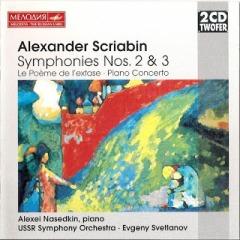Scriabin - Symphonies Nos.2 & 3 (Svetlanov) [1999]
Scriabin - Symphonies Nos.2 & 3 (Svetlanov) [1999]

Disc 1: 1-5. Symphony No. 2 In C Minor, Op.29 6. Le Poeme De L' Extase, Op.54 Disc 2: 1-3. Symphony No. 3 In C Minor, Op.43 (Le Divine Poeme) 4-6. Concerto For Piano And Orchestra In F-Sharp Minor, Op. 20 Yuri Krivosheyev (Trumpet) Alexei Nasedkin (Piano) USSR Symphony Orchestra Evgeny Svetlanov - conductor
The Second Symphony was completed in 1901, a year after the first. It is the most traditional of his symphonies in formal structure. The first two movements (Andante, Allegro) are played without a break and structurally form a classical sonata movement. In the third movement (Andante), however, he makes a remarkable advancement toward the heavily chromatic sound associated with the mature Scriabin. The movement opens with a birdsong played by the flute, another Scriabin characteristic. The rest of the movement, with its frequent evocations of birdsong and other sounds of nature, is like a long, dreamy walk through the wilderness. Even the central climax is unforced. A lovely movement, the fourth movement (Tempestuoso), a minor-key scherzo, is full of turbulent string, timpani, and brass writing, interrupted briefly in places by some more lyrical writing. Toward the end of the movement, the key modulates into the major and leads seamlessly into the final Maestoso movement with a majestic restatement of the symphony's opening theme. This generally uninspired movement lacks interesting harmonic or thematic development, and the conclusion is tepid. Even Scriabin said of the last movement, "I liked it when I wrote it, but now it doesn't please me anymore...the last part is banal." This work marks important strides in Scriabin's growth as a composer, and still shocked its initial audience somewhat when it premiered in St. Petersburg under the baton of Anatol Lyadov on January 12, 1902, but it is hard to recommend for general listening except for the true Scriabin devotee. --- John Dobson, Rovi
Scriabin's Symphony No. 3 is the first of the composer's major orchestral works to bear explicit extramusical intent. The titles appended to each movement are as colorful as the music itself : "Luttes" (Struggles), "Voluptes" (Pleasures), and "Jeu divin" (Divine Play). The work's performance instructions go well beyond the traditional Allegro or Andante; here, markings such as "mysterieux," "tragique," and "sublime" appear in Scriabin's orchestral music for the first time. These indications represent far more than superficial descriptions; indeed, they demonstrate the struggle Scriabin and his contemporaries faced in trying to express the turbulent emotions of their music in conventional terms. In the program notes for the premiere, Scriabin noted that his "Divine Poem" represents the growth of the human spirit as it is freed from legends and mysteries, passes through pantheism, and ultimately affirms its liberty and unity with the universe.
"Luttes" is meant to represent the conflict between man enslaved by another God versus man himself in the role of God himself. It opens with an ominous theme in the brass; the strings soon enter with an agitated minor-mode motive that gradually migrates toward a theme in the major mode. From this point, there is no longer any solid sense of tonality, and shifts between major and minor occur suddenly and frequently. Dynamic levels are similarly in constant flux, and at times it seems as though climaxes spring up every few measures. Nevertheless, Scriabin's mastery is such that he is able to bind this long movement into a cohesive whole despite its inescapably episodic nature. "Voluptes" is pure sonic sensuality. From a quiet opening of saccharine music for winds and strings, the movement gradually builds into an expression of unbridled, powerful sensuality. This movement leads without interruption into "Jeu divin," where the spirit, freed from submission to a higher power, relinquishes itself to the supreme joy of a free existence. This is rich and richly exciting music, characterized by a torrent of unpredictable changes of mood. The work ends, with a note of gentle ecstasy, on a Brahmsian final chord. Though the work clearly lacks the maturity of later masterpieces like the Poem of Ecstasy (1905-08) or Prometheus (1908-10), it is still a highly individual and worthy effort that provides a fascinating glimpse into the development of Scriabin's singular aesthetic. --- John Dobson, Rovi
download: uploaded yandex 4shared mediafire mega zalivalka filecloudio anonfiles oboom
Zmieniony (Niedziela, 04 Maj 2014 14:12)








